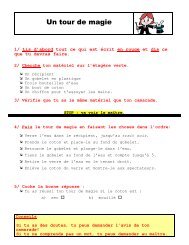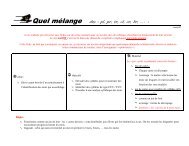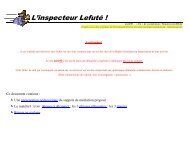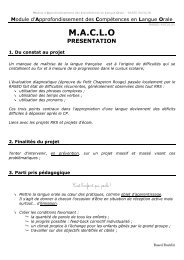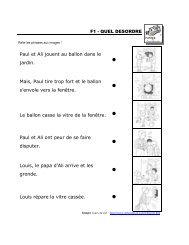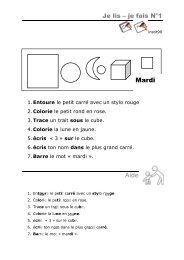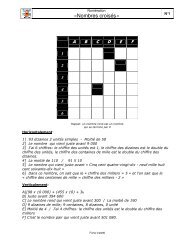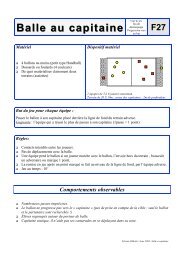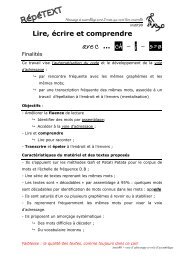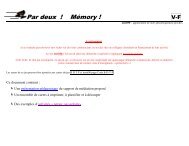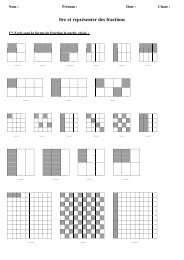Je sais légender le schéma d'un volcan - Instit90
Je sais légender le schéma d'un volcan - Instit90
Je sais légender le schéma d'un volcan - Instit90
You also want an ePaper? Increase the reach of your titles
YUMPU automatically turns print PDFs into web optimized ePapers that Google loves.
Les Les <strong>volcan</strong>s <strong>volcan</strong>s <strong>volcan</strong>s<br />
… / 20<br />
instit90<br />
� <strong>Je</strong> <strong>sais</strong> <strong>légender</strong> <strong>le</strong> <strong>schéma</strong> d’un <strong>volcan</strong> : … / 3<br />
<strong>Je</strong> place correctement : « coulée de lave ; cheminée ; réservoir magmatique ; cratère ; cône <strong>volcan</strong>ique ».<br />
� <strong>Je</strong> connais <strong>le</strong> vocabulaire: … / 6<br />
Projections * *<br />
lave * *<br />
magma * *<br />
Eruption effusive * *<br />
Eruption explosive * *<br />
Cône <strong>volcan</strong>ique * *<br />
Magma à la sortie du <strong>volcan</strong>, plus ou<br />
moins visqueux selon sa composition.<br />
Roches en fusion qui remontent d’un<br />
réservoir magmatique par la cheminée du<br />
<strong>volcan</strong>.<br />
Montagne formée par l’accumulation de<br />
laves et de cendres expulsés lors<br />
d’éruptions <strong>volcan</strong>iques.<br />
Eruption vio<strong>le</strong>nte avec émission de<br />
panaches de fumées, de nuées ardentes,<br />
etc…<br />
Matériaux (cendres, fumées, gaz, bombes<br />
<strong>volcan</strong>iques, lave….) projetés lors d’une<br />
éruption.<br />
Eruption <strong>volcan</strong>ique « calme » rejetant des<br />
coulées de lave et souvent une « fontaine »<br />
de projecti<strong>le</strong>s.
� <strong>Je</strong> <strong>sais</strong> reconnaître un <strong>volcan</strong> d’après la description d’une de ses éruptions : … / 6<br />
Volcan explosif * *<br />
Volcan effusif * *<br />
Une lave fluide descend en coulées sur de grandes distances. La lave<br />
projetée en l’air par la libération des gaz contenus dans <strong>le</strong> magma, forme<br />
des projections de tail<strong>le</strong>s variab<strong>le</strong>s qui refroidissent lors de <strong>le</strong>ur trajet<br />
dans l'air. En retombant el<strong>le</strong>s s'accumu<strong>le</strong>nt et forment progressivement<br />
<strong>le</strong> cône du <strong>volcan</strong>. Les plus grosses deviennent des bombes<br />
<strong>volcan</strong>iques de formes plus ou moins allongées<br />
Une lave épaisse, visqueuse s’est refroidie et bouche la cheminée du<br />
<strong>volcan</strong>. Brusquement, <strong>le</strong>s gaz accumulés se libèrent. Une partie du<br />
<strong>volcan</strong> est détruite et des blocs de roches sont libérés. Une nuée<br />
ardente destructrice déva<strong>le</strong> du <strong>volcan</strong>.<br />
Complète <strong>le</strong>s légendes par :<br />
� Un <strong>volcan</strong> effusif, <strong>le</strong> Piton de la Fournaise.<br />
� Un <strong>volcan</strong> explosif, <strong>le</strong> <strong>volcan</strong> Mayon aux Philippines.<br />
………………………………………………………<br />
……………………………………………………..<br />
………………………………………………………<br />
……………………………………………………..<br />
� Vrai ou Faux: … / 3<br />
1 Le magma est constitué de roches en fusion.<br />
2 Un <strong>volcan</strong> effusif est plus dangereux qu’un <strong>volcan</strong> explosif.<br />
3<br />
Une nuée ardente est un mélange de gaz et de cendres à très haute température qui<br />
déva<strong>le</strong> à grande vitesse <strong>le</strong>s flancs du <strong>volcan</strong>.<br />
� Réponds aux questions : … / 2<br />
Comment appel<strong>le</strong>-t-on un scientifique qui observe <strong>le</strong>s <strong>volcan</strong>s ? ………………………………..……<br />
Pourquoi <strong>le</strong> magma remonte-t-il à la surface ? ………………………………………………………..<br />
………………………………………………………………………………………………………….



